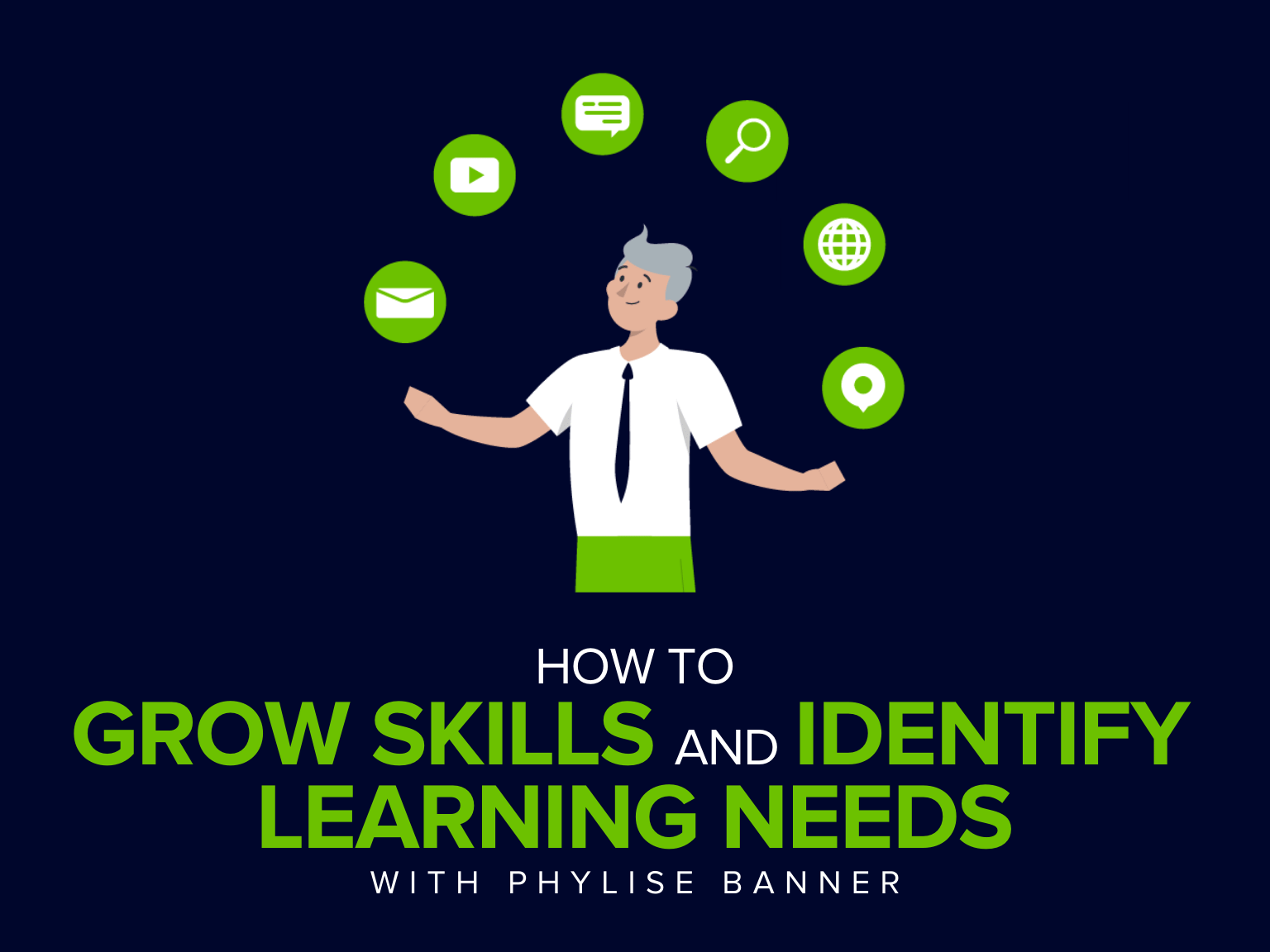What is a maturity matrix and how can it help you grow your skills?
Sometimes the most effective tools are the simplest. While a name like “maturity matrix” doesn’t necessarily sound that simple, Phylise Banner explains how easy they are to use, why they’re beneficial for exposing skills gaps, and how they can motivate you to take your skills to the next level.
Phylise Banner is an innovative Learning Experience Design Consultant. Her career spans experience in instructional design and online learning. She takes a practical approach to designing learning experiences and creates inventive ways to address learning needs.
In this post, Phylise addresses how you can approach developing your skills and what practical steps you can take to work through the process.
You can watch the video on this topic at the top of this post, to listen to the podcast episode, hit play below, or read on for more…
How to approach skills development
When you start a new job or begin developing a new skill, you’re often motivated to learn quickly and advance. But as your skills become more developed, it can be harder to continue progressing.
Often, people’s skills stagnate because they don’t know what steps to take next. While we can all agree that you don’t know what you don’t know, Phylise argues that by changing your mindset, you can create a pathway.
“Putting yourself in a mindset of somebody else who does know what you don’t know, you realize that there’s probably established practices out there that you can find out about.”
You might want to climb a mountain, for example, but it feels impossible. You’re not a mountain climber and you don’t even know where to start. However, by thinking what steps a mountain climber would take, you can break your goal down into manageable steps. These steps then become a roadmap to get you from where you are to the very top of that mountain.
Phylise designed a deceptively simple tool that can help anyone plot out their pathways to developing any skill. She calls it the ‘maturity matrix’.
What is a maturity matrix?
You might have heard or even used a skills matrix before. This is where you undertake a skills assessment or consider what skills you already have and the ones you’d like in future. But this doesn’t give you a roadmap to sufficiently grow your skills.
A maturity matrix helps you define steps for how to grow or ‘mature’ your skills. It’s a tool which encourages you to consider the spectrum of your skill, where you are on it, and what you can do to progress to the next level.
“Consider what the spectrum looks like. What’s ‘okay’, ‘good’, ‘better’, or ‘best’? What attributes would be classified as ‘best’? What would be classified as ‘good’? What’s ‘good enough’? If I drew all that out or documented that in some way, shape or form, how I could use that as a roadmap?”
A completed maturity matrix becomes a skills mentor, guiding you through the steps that you’ve plotted from A to B.
There’s no wrong approach to a maturity matrix. You can be as granular or as broad as you like, and, most importantly, there’s no failure.

The maturity matrix is all about empowering yourself to progress and Phylise strongly believes in designing supportive learning practices. The matrix steers away from failure and instead praises success.
How to design your own maturity matrix
A maturity matrix isn’t as complicated as the name suggests. In fact, to design your own, all you need to start with is a basic grid. It should be at least three columns wide and at least two rows deep.

The first column is where you’ll put the skills you want to develop, in the example below “Understanding processes” and “Organization”. You can put as many skills as you want in this column. These can be career-related, project specific, for personal development, or any other skill that you’d like to progress in.

The first row is your maturity levels. There are many ways you can choose to express these, from numbering each level 1-5, to using the good, better, best spectrum, or being more creative. We’ve chosen “roll”, “crawl”, “walk”, “run”, and “fly”.
Each level should be a progression from the last one. This is what makes the maturity matrix a pathway as you can plot your development across the grid as your skills grow.

Finally, you need to define what you need to be able to do in that skill that’s appropriate to each level. You might find the lower levels are easier to fill in, but as you start to think further into your skill’s potential you may find it more difficult.
Phylise’s top tip is to think about a person who’s mastered this skill and what elements you’d like to replicate. Use this to continue building your skill pathway.
“There is no reason not to use the things you admire. Because the things admire are the things you want you will aspire to.”
Phylise encourages everyone not to stop at what they consider ‘best’, but to think beyond that. Use your imagination to go further than the highest level. If best to you is climbing the highest mountain in your state, then better than best could be climbing the highest mountain in the U.S.!

Who can use a maturity matrix?
A maturity matrix can be used by anyone for any skill. Personal, professional, individual or group, there are no limitations because you design it yourself.
While our example focused on self-development, you could use a maturity matrix in place of a performance evaluation for your team. You could work with members of your team to design a maturity matrix that you’re both happy with and plot their progress annually, monthly, or however you choose to do it.
Reviewing performance in this way is much more effective than simply stating whether they’ve reached their target or not. It gives actionable steps to ensure that your team member knows what they have to do to progress. It’s more motivating for them and holds you accountable to recognizing their development when they reach that next level.
You don’t have to limit this tool to use by individuals only, you can also use it to develop teams. Phylise believes that they can help teams reach a collective goal.
“As a team building exercise, it gives us that input, it helps us grow and gel around effective practices.”
By pulling together a maturity matrix that an entire team is on board with, everyone knows what stage of the project they’re at, and what they need to do in order to progress to the next step. It works the same way as an individual matrix, but it helps keep everyone on the same page and accountable for the team’s progress.
How a maturity matrix could work for you
Phylise’s maturity matrix can help you stay motivated to achieve your skills because you design your own pathway. You can consider your learning styles, comfort zone, and any other factors that can affect your development and create a process that’s going to work for you.
Her final words of advice for using a maturity matrix and your overall approach to learning and development are never to limit what you can achieve.
“Share your insight. Trust your instincts. And use your imagination in in this exercise. Incorporate your imagination into your work. You will go far with that.”
If you enjoyed this post and want practical help with achieving more, head over to the TechSmith Academy where we share lots of free resources that can aid your skills development.
For further expert advice and tips visit TechSmith Academy on YouTube or listen to the Podcast.





